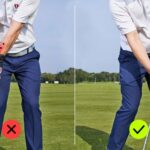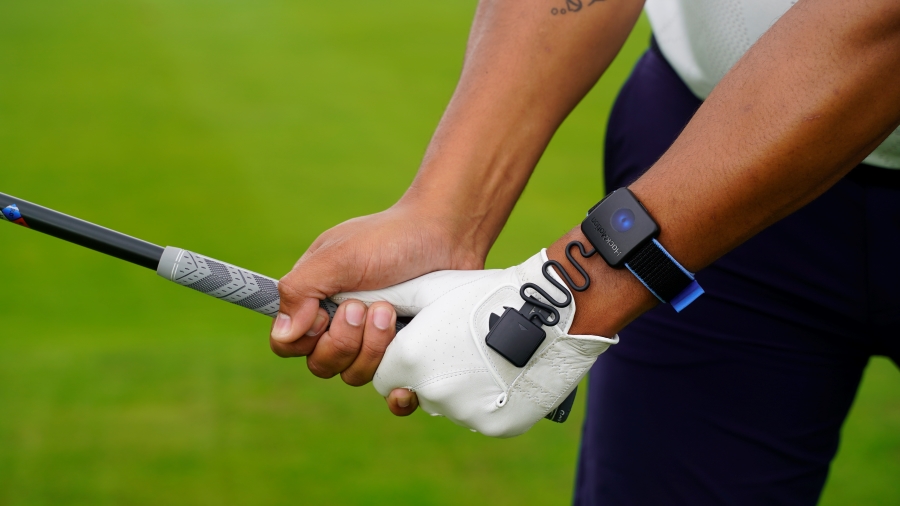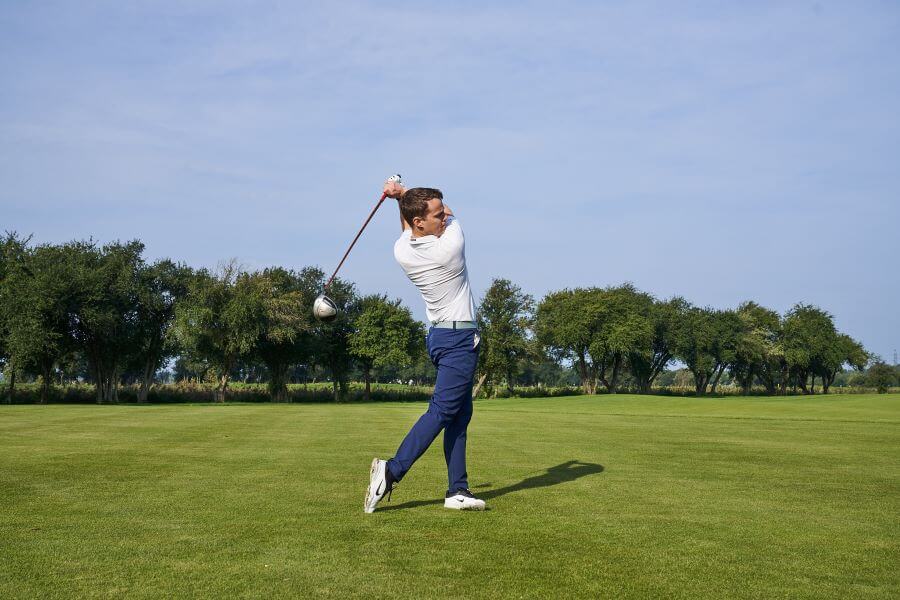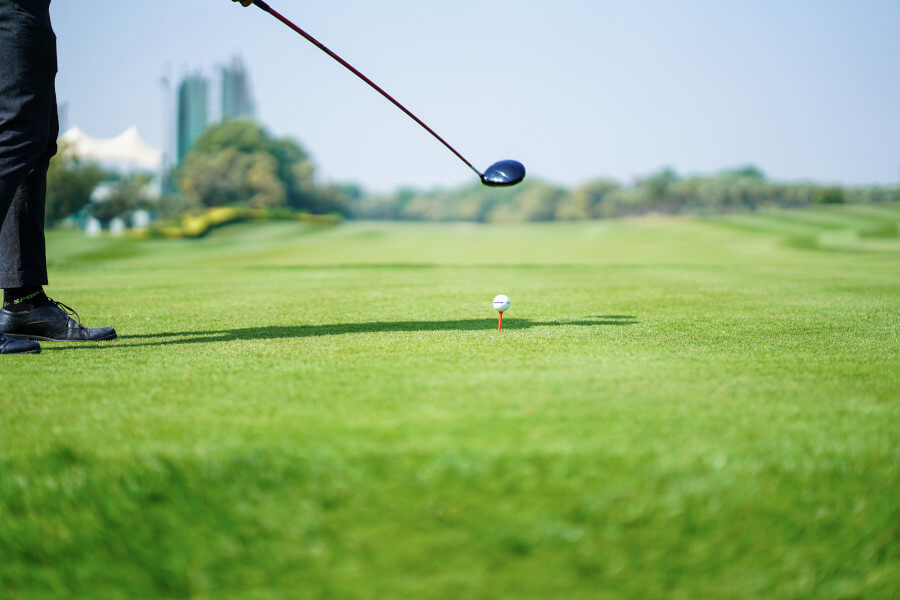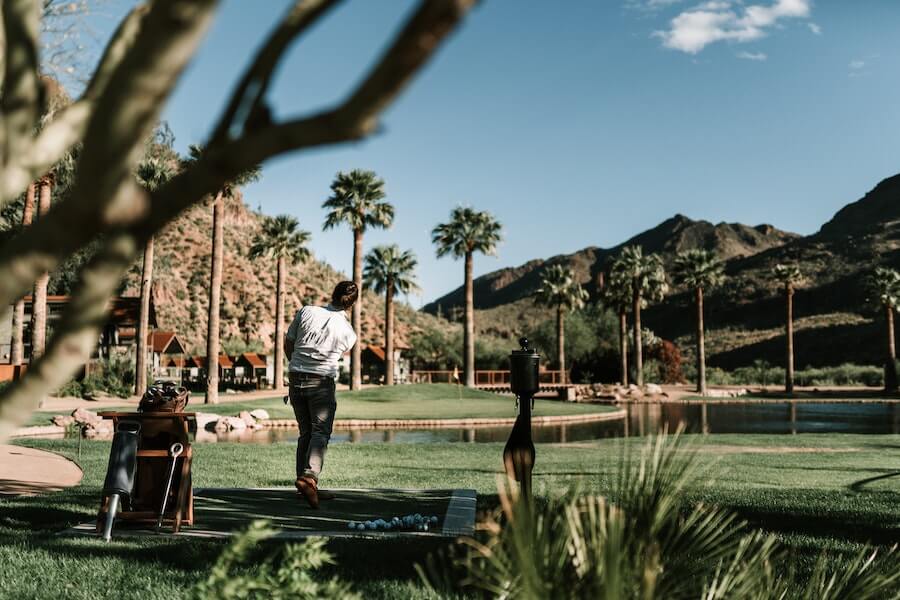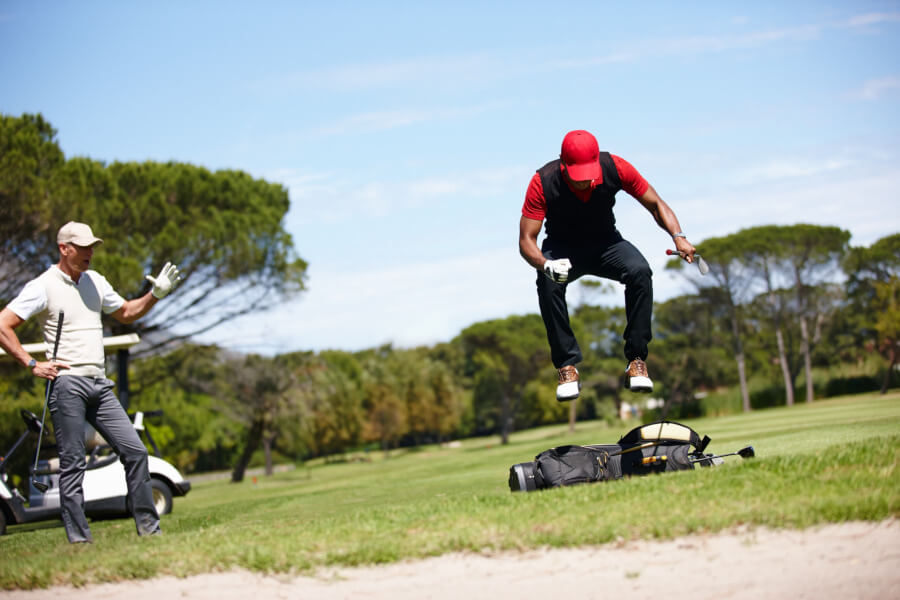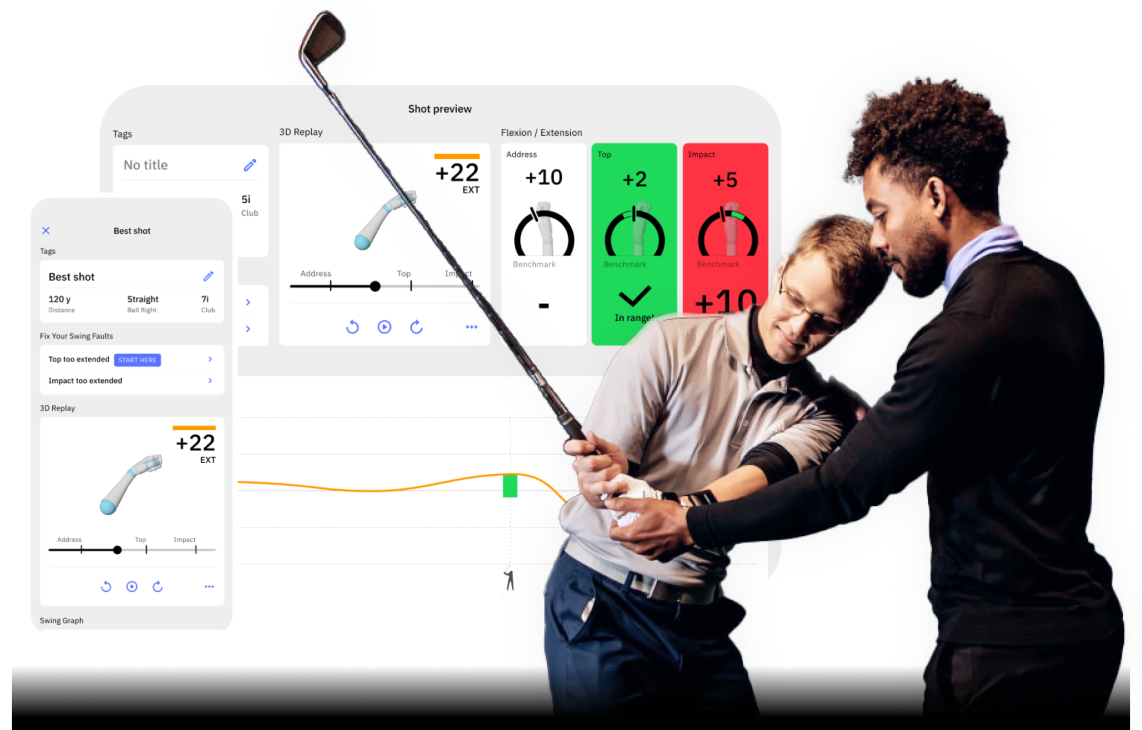How to Hit a Golf Ball Above Your Feet (Setup Adjustments, Swing Tips & Drills)
Few lies in golf feel as awkward as the one where the ball sits above your feet. The ground is tilted, the ball feels too close, and your instincts start arguing with your fundamentals.
But with the right setup and a couple of smart swing cues, you can turn this tricky situation into a controlled, confident shot that finds your target more often than not.
This guide breaks down what this lie does to your ball flight and swing plane, how to adjust your setup, what to expect with your wrist and body movements, and how to make reliable contact from this sidehill situation.
There are also specific drills you can print and bring to the range to address this unique shot, turning it from a weakness into a strength.
Ball Above Feet in Golf (Key Takeaways)
Review these notes to give you a good idea of how to prepare for when you encounter a ball above your feet situation, both in the long and short game.
- Make adjustments to your setup and posture based on the slope you’re faced with.
- Anticipate more distance and account for it with proper club selection.
- Control your wrist and forearm rotation through impact.
- Utilize your body rotation and minimize arm movement.
- Address the change in trajectory and rollout based on the severity of the slope.
Contents
Why the Ball Above Your Feet Makes Shots Go Left and Lower
When the ball is above your feet, the club sits more “toe-up” at address. That changes the effective lie angle, which subtly points the face left of your target at impact if you swing normally.
Additionally, the slope encourages a flatter, more around-the-body swing plane. A flatter plane tends to close the face more relative to the path and can increase right-to-left curvature.
Combine those two, and you get a ball that starts left and often curves farther left.
You’ll also notice the ball launches lower. This is because the effective loft is reduced when the face rotates closed relative to the path, and players often shorten the swing or choke down for control, both of which lower the ball’s height. Expect more roll after landing as well. Planning for that lower flight and leftward bias is the first step to playing this shot well.
The club works more around your body. If you fight this and try to swing steeply, you risk digging the heel, pulling the face even more left, or hitting it heavy.
The smart play is to accept a slightly flatter plane and manage it with simple setup and aim adjustments. Many instructors teach “swing with the slope,” which means you let the terrain influence your shape rather than attacking it with a normal, level-lie move.
How to Hit a Golf Ball Above Your Feet
Set Up Adjustments that Make this Shot Easier
Setup does most of the heavy lifting when the ball is above your feet. A few minor tweaks neutralize the left bias and help your body move comfortably around the slope.
Here’s a compact checklist you can use:
- Grip down on the club: Choke down about 0.5 to 1 inch, maybe more with longer clubs. The ball is effectively closer to you, and gripping down shortens the swing radius so you can center the strike and avoid heel-digging.
- Aim right of the target: Since the shot wants to start left and turn left, align your entire body a few yards right. How much depends on the severity of the slope and the club you’re using. Higher lofts (short irons, wedges) may require more compensation.
- Stand a touch taller: Reduce your forward bend slightly to match the ball’s higher position. Too much knee flex can trap the club under the plane and over-close the face. A taller posture encourages a controlled, balanced turn.
- Balance toward your heels: The slope tends to pull your weight toward your toes during the swing. Starting with a fraction more weight in your heels keeps you centered and prevents falling forward.
- Adjust the face subtly: Aim your body slightly to the right and set the clubface just a touch open relative to your stance. This combination reduces the left start and helps limit hook spin. Keep it subtle, you’re shaping the shot, not reinventing your swing.
- Ball position slightly back of normal: A half-ball to one ball back can help control face closure and ensure ball-first contact. Don’t overdo it; too far back steepens the strike and fights the natural plane.
For short-game shots, use the same tips, but even more subtly. The speed of the swing and high loft of clubs tend to counteract each other. Reference the video below to learn how to handle short shots when the ball is above your feet.
Distance Control and Club Selection
Distance from this lie can be tricky. You’re gripping down, which usually costs yardage. Yet the lower launch and reduced spin can add run-out and sometimes maintain carry.
A conservative rule of thumb is to expect a lower ball flight that won’t carry quite as far but might chase after landing.
If there’s trouble long, grip down and play the normal club. If you must clear something with carry and the slope is mild, consider one more club and a smooth swing.
Always factor in the lie severity: steeper slopes magnify left curvature and lower flight.
Choosing the right club also matters.
Hybrids can be friendly here because they’re forgiving from uneven lies, but they can also hook. If left is dead, favor something with less offset to reduce face closure. With long irons and fairway woods, you can be more precise, with wedges and short irons, double down on your aim right and face management.
Wrist and Forearm Tendencies You Should Control
When the ball is above your feet, your wrists and forearms want to rotate more, adding to the hook.
Think of a “quiet” clubface throughout the swing. Keep your grip pressure even. It should be firm enough to control but light enough to stay fluid.
Try to feel a flatter lead wrist through impact rather than an aggressive roll-over. Some players like the cue “hold the face off” through the ball, which means your lead wrist stays more stable and your trail hand doesn’t flip dramatically.
You’re not trying to hit a fade; you’re just softening the rollover.
The HackMotion sensor is specifically designed to address wrist movement. The system will alert you when your wrists are out of position and then recommend specific drills to help you correct your wrist action.
Body Movement and Balance Cues
Your biggest priority is balance. The slope will want to pull you down the hill or force you to overcompensate toward your toes.
- Start balanced with your weight slightly in your heels.
- Keep your head steady while your chest turns around your spine.
- Use a slightly shorter backswing to help you maintain posture and tempo.
- During the through-swing, let the hill rotate you; don’t lunge or chase the ball down the slope.
- Imagine your shirt buttons staying the same distance from the ball throughout the swing.
Because the plane is flatter, your arms will travel more around your body. Let them. Fighting to lift the club vertically invites heel strikes and steep, glancing contact.
Instead, focus on width—arms extended, not collapsed—and a smooth tempo. A narrower, controlled finish is fine; you don’t need a full-bore release when the ground’s telling you the ball will curve anyway.
Trajectory Management and Shot Planning
There are two practical strategies:
- Accept a gentle draw and aim accordingly. For most golfers, that’s the highest-percentage play. Start right, make a balanced swing, and let the slope do the rest.
- Neutralize the hook by holding the face slightly open through impact with a shorter finish. This can give you a straighter flight or a “push-draw” that starts more to the right and curves back less.
If the target is guarded on the left or there’s a hazard there, consider an even safer line right of the flag.
Remember, your ball will likely come in flatter and run farther; use that to your advantage by landing it short right and letting it release.
- Video Timestamp: 1:42 – 2:35
Common Mistakes and Quick Fixes
- Over-swinging exaggerates face rotation and balance issues. The fix is to use a shorter backswing, a controlled tempo, and a three-quarter finish.
- Aiming at the pin when the ball wants to go left. Always aim a little right, even if it feels like too much, trust your setup.
- Not gripping down and using the full-length grip brings the heel into play. Be sure to choke down enough that the sole looks more flush and your strike centers up.
- Falling toward the toes and letting the slope pull you forward. Always start with a touch more weight in your heels and keep your chest centered.
- An overly open face or an extremely weak grip can cause a push that never draws back. Make subtle changes and let the slope contribute.
Drills to Practice Hitting Shots with the Ball Above Your Feet
Take these drills to the range and find yourself a lie where the ball is above your feet.
You may have to go to the other side of the range or a different range than your usual spot, but with these drills, you won’t have to put in too much time.
Motorcycle Drill
This drill is perfect for controlling your wrist action and forearm movement.
With the ball above your feet, you’ll want to prevent too much rotation here that will cause the ball to veer wildly to the left.
- Video Timestamp: 7:02 – 11:38
Motorcycle Drill – Step by Step
- Open the app and calibrate your sensors using the on-screen prompts.
- Select the motorcycle drill from the drill library, then get into your normal address position.
- Once your wrists are in the correct position, the app will instruct you to start your swing.
- At the top of your swing or during the downswing, you may need to rotate your wrists to accommodate the ball-above-your-feet lie.
- Follow the app’s alerts to keep your wrists in the correct position.
Body Rotation Drill
Smooth rotation is the key when adjusting your posture to accommodate an uneven lie. When the ball is above your feet, you’re forced to stand taller, which encourages more arm swing.
This drill will ensure you incorporate your body and channel the power correctly into crisp, clean contact.
- Video Timestamp: 2:06 – 4:36
Body Rotation Drill – Step by Step
- Place a small ball (basketball or volleyball) between your forearms just above the wrists.
- Start by taking half practice swings to get used to using your body without letting the ball drop.
- You can begin hitting balls with the same half swings and ensure you’re getting good contact.
- Eventually work your way up to a pretty full swing, but don’t worry if you can’t do your full backswing or full follow-through. The drill is still very effective even with half swings.
Towel Drill
Adjusting the low point of your swing is a tough ask when dealing with a ball-above-your-feet lie. This drill addresses that and only requires a small towel and a sidehill lie.
The towel provides a visual and physical barrier to bottoming out too early.
- Video Timestamp: 7:28 – 9:54
Towel Drill – Step by Step
- Lay down a small towel about eight inches behind your ball.
- Hit balls from the sidehill lie without hitting the towel.
- As you improve, you can move the towel closer to the ball to increase the difficulty and challenge yourself more.
Final Thoughts
A ball-above-feet lie doesn’t have to wreck your hole. It simply changes the geometry of your setup and swing, nudging the ball left and lowering the flight. If you accept that and make a few calculated adjustments, you’ll turn a nervy situation into a reliable, repeatable shot.
Hackmotion is a great tool to tackle this issue. Among Hackmotion’s many uses, its ability to track your movements and record your practice sessions is one of the most valuable. It will also make personal drill recommendations based on data from your practice sessions.
The next time you find your ball perched above your feet, think less about fighting the slope and more about partnering with it.





